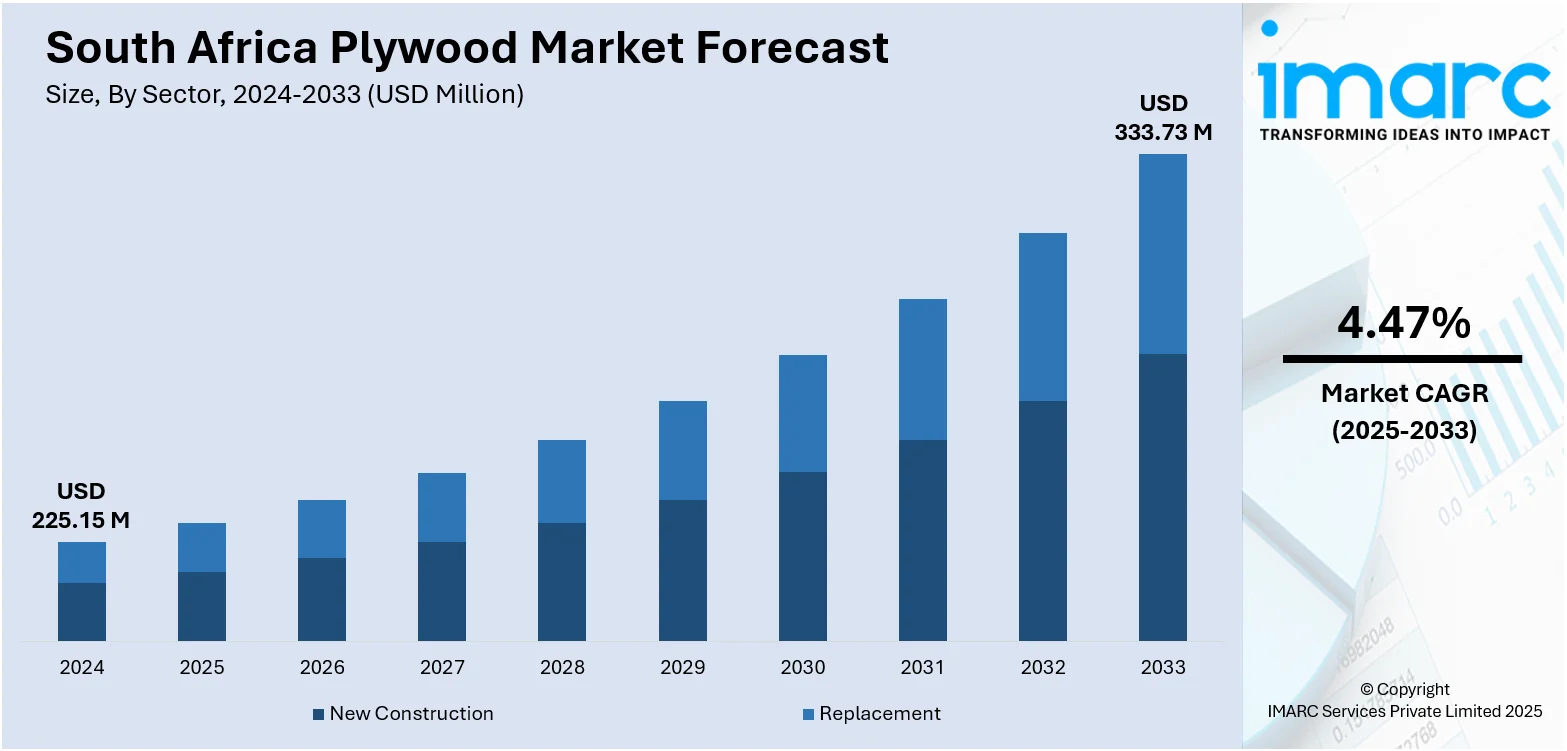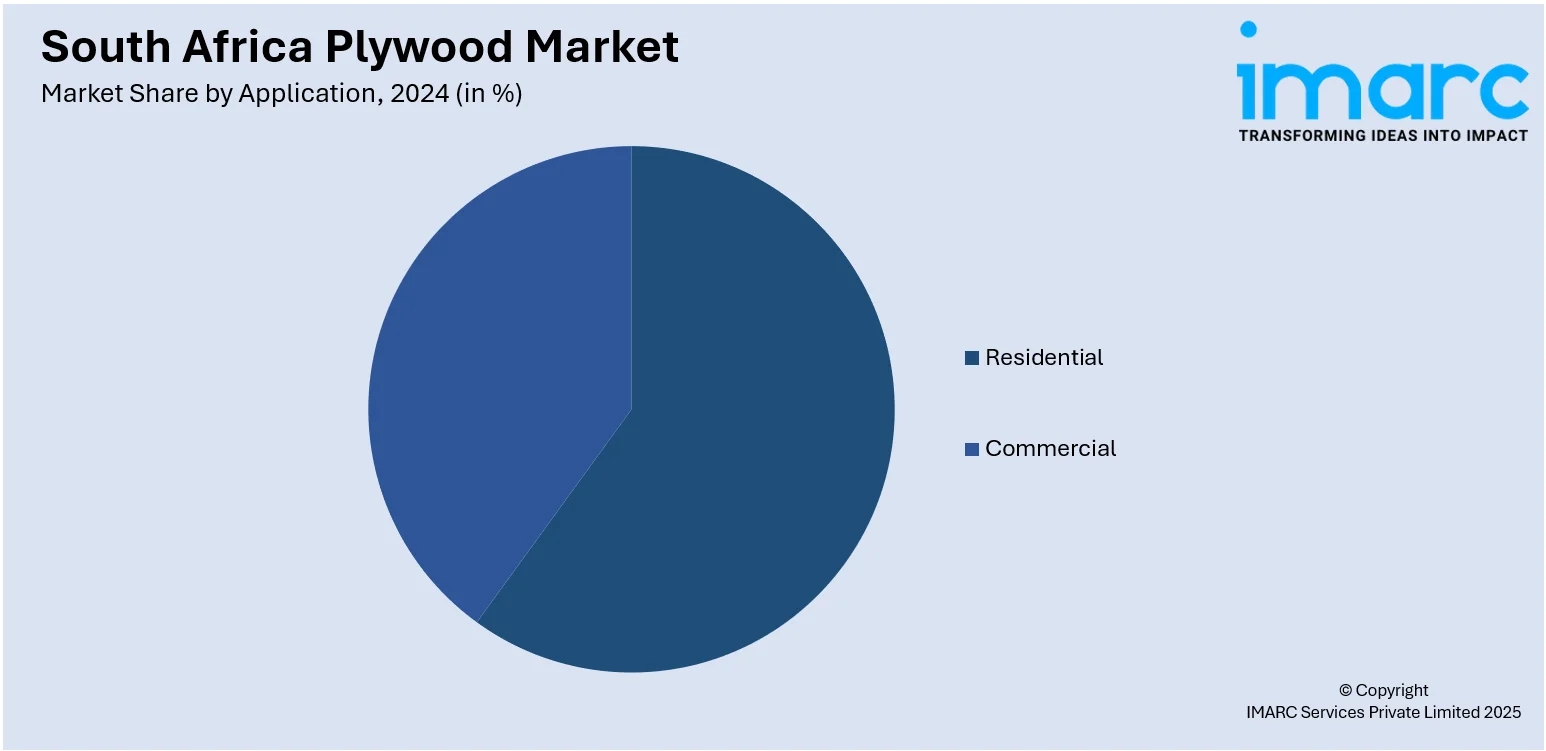
South Africa Plywood Market Size, Share, Trends and Forecast by Application, Sector, and Province, 2025-2033
South Africa Plywood Market Overview:
The South Africa plywood market size reached USD 225.15 Million in 2024. The market is projected to reach USD 333.73 Million by 2033, exhibiting a growth rate (CAGR) of 4.47% during 2025-2033. As the international demand is rising for cost-effective, resilient, and versatile construction materials, South Africa's abundant forestry resources and burgeoning timber sector are positioning it as a significant exporter. Besides this, increasing tourism activities, which are facilitating urban and rural development, are contributing to the expansion of the South Africa plywood market share.
|
Report Attribute
|
Key Statistics
|
|---|---|
|
Base Year
|
2024
|
|
Forecast Years
|
2025-2033
|
|
Historical Years
|
2019-2024
|
| Market Size in 2024 | USD 225.15 Million |
| Market Forecast in 2033 | USD 333.73 Million |
| Market Growth Rate 2025-2033 | 4.47% |
South Africa Plywood Market Trends:
Increasing plywood exports
Rising plywood exports are supporting the market expansion in South Africa. As per the OEC, in 2024, South Africa exported ZAR306 Million worth of plywood. With the international demand increasing for affordable, durable, and adaptable construction materials, South Africa’s rich forestry assets and thriving timber industry are making it a notable exporter. These export opportunities are motivating domestic manufacturers to refine product quality, adopt modern production methods, and align with worldwide regulatory standards. This shift is not only enhancing the value of plywood products but also drawing international investment into the sector. The growth in exports is also creating jobs in areas, such as logging, manufacturing, and logistics, contributing significantly to South Africa’s economy. Additionally, greater export volumes help reduce reliance on domestic demand, strengthening the industry's stability. Export-led development is promoting responsible forestry, while government support through trade incentives and infrastructure upgrades is creating the need for plywood. It is also encouraging producers to diversify their product lines to serve sectors like construction, automotive, and packaging. Consistent export revenue is enabling further investments in research and development (R&D) activities and plant upgrades, thereby bolstering the South Africa plywood market growth.

To get more information on this market, Request Sample
Rising tourism activities
With the rise in both local and international tourism, South Africa is witnessing increasing demand for new infrastructure, such as hotels, lodges, resorts, cultural venues, and transportation centers. As per the Statistics South Africa, in 2024, South Africa continued to be a leading destination, welcoming 8.9 Million visitors, reflecting a growth of 5.1% compared to 2023. Plywood, valued for its strength, affordability, and versatility, plays an important role in the construction of these spaces, which are used extensively in structural frameworks, furniture, wall coverings, partitions, and aesthetic enhancements. As the tourism industry is burgeoning in the country, existing hospitality facilities are undergoing renovations and modernization to cater to evolving guest expectations, where plywood is widely employed for interior redesign and functional upgrades. In addition, the foodservice industry, including restaurants, cafes, and souvenir outlets, is adopting plywood in the creation of trendy and practical fixtures that appeal to tourists. Beyond hospitality, the overall growth of tourism is facilitating urban and rural development across scenic and heritage-rich regions, catalyzing the demand for plywood in related housing and commercial projects. This industry-wide momentum, driven by the country’s expanding tourism appeal, is reinforcing plywood’s role as a go-to construction and design material. It is supporting job creation across construction, carpentry, and interior design sectors, while also motivating plywood manufacturers to innovate in finishes, textures, and sustainable solutions suited for high-traffic hospitality environments.
South Africa Plywood Market Segmentation:
IMARC Group provides an analysis of the key trends in each segment of the market, along with forecasts at the country and regional levels for 2025-2033. Our report has categorized the market based on application and sector.
Application Insights:

- Residential
- Commercial
The report has provided a detailed breakup and analysis of the market based on the application. This includes residential and commercial.
Sector Insights:
- New Construction
- Replacement
A detailed breakup and analysis of the market based on the sector have also been provided in the report. This includes new construction and replacement.
Provinical Insights:
- Gauteng
- KwaZulu-Natal
- Western Cape
- Mpumalanga
- Eastern Cape
- Others
The report has also provided a comprehensive analysis of all the major regional markets, which include Gauteng, KwaZulu-Natal, Western Cape, Mpumalanga, Eastern Cape, and others.
Competitive Landscape:
The market research report has also provided a comprehensive analysis of the competitive landscape. Competitive analysis such as market structure, key player positioning, top winning strategies, competitive dashboard, and company evaluation quadrant has been covered in the report. Also, detailed profiles of all major companies have been provided.
South Africa Plywood Market News:
- In February 2024, Serco, a prominent producer of truck bodies in South Africa, teamed up with UPM Plywood to provide unique and lasting transport solutions based on the values of quality and innovation. With its manufacturing facilities situated in Durban, Cape Town, Johannesburg, and Port Elizabeth, Serco prioritized sustainability while offering transporters an edge in their fields.
South Africa Plywood Market Report Coverage:
| Report Features | Details |
|---|---|
| Base Year of the Analysis | 2024 |
| Historical Period | 2019-2024 |
| Forecast Period | 2025-2033 |
| Units | Million USD |
| Scope of the Report |
Exploration of Historical Trends and Market Outlook, Industry Catalysts and Challenges, Segment-Wise Historical and Future Market Assessment:
|
| Applications Covered | Residential, Commercial |
| Sectors Covered | New Construction, Replacement |
| Provinces Covered | Gauteng, KwaZulu-Natal, Western Cape, Mpumalanga, Eastern Cape, Others |
| Customization Scope | 10% Free Customization |
| Post-Sale Analyst Support | 10-12 Weeks |
| Delivery Format | PDF and Excel through Email (We can also provide the editable version of the report in PPT/Word format on special request) |
Key Questions Answered in This Report:
- How has the South Africa plywood market performed so far and how will it perform in the coming years?
- What is the breakup of the South Africa plywood market on the basis of application?
- What is the breakup of the South Africa plywood market on the basis of sector?
- What is the breakup of the South Africa plywood market on the basis of province?
- What are the various stages in the value chain of the South Africa plywood market?
- What are the key driving factors and challenges in the South Africa plywood market?
- What is the structure of the South Africa plywood market and who are the key players?
- What is the degree of competition in the South Africa plywood market?
Key Benefits for Stakeholders:
- IMARC’s industry report offers a comprehensive quantitative analysis of various market segments, historical and current market trends, market forecasts, and dynamics of the South Africa plywood market from 2019-2033.
- The research report provides the latest information on the market drivers, challenges, and opportunities in the South Africa plywood market.
- Porter's five forces analysis assist stakeholders in assessing the impact of new entrants, competitive rivalry, supplier power, buyer power, and the threat of substitution. It helps stakeholders to analyze the level of competition within the South Africa plywood industry and its attractiveness.
- Competitive landscape allows stakeholders to understand their competitive environment and provides an insight into the current positions of key players in the market.
Need more help?
- Speak to our experienced analysts for insights on the current market scenarios.
- Include additional segments and countries to customize the report as per your requirement.
- Gain an unparalleled competitive advantage in your domain by understanding how to utilize the report and positively impacting your operations and revenue.
- For further assistance, please connect with our analysts.
 Request Customization
Request Customization
 Speak to an Analyst
Speak to an Analyst
 Request Brochure
Request Brochure
 Inquire Before Buying
Inquire Before Buying




.webp)




.webp)












